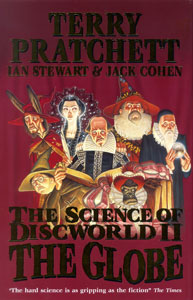The Science of Discworld II: The Globe
 |
|
| Authors | Terry Pratchett, Ian Stewart & Jack Cohen |
|---|---|
| Language | English |
| Series |
Discworld 2nd science novel |
| Subject |
|
| Genre | Fantasy |
| Published | 2002 (Random House) |
| ISBN | |
| Preceded by | The Science of Discworld |
| Followed by | The Science of Discworld III: Darwin's Watch |
The Science of Discworld II: The Globe is a 2002 book written by British novelist Terry Pratchett and science writers Ian Stewart and Jack Cohen. It is a sequel to The Science of Discworld, and is followed by The Science of Discworld III: Darwin's Watch.
The book alternates between a typically absurd Discworld story and serious scientific exposition.
Where the first book centred on the origins of the universe, earth and the beginnings of life, the second part follows the modern history of Earth. The central theme in the book is that in order for humans to understand anything it must be encapsulated in a story. In the fictional part of the book this is symbolized by the fictional element 'narrativium'. The science section suggests that, rather than Homo sapiens (Wise Man), we might be better described as Pan narrans (Storytelling Chimpanzee).
In the story, the wizards accidentally are transported to Roundworld (the real universe, inadvertently created during the first book) during the Elizabethan era. This is the first time they learn there are humans on Roundworld; they previously learnt that something would escape an Ice Age by heading for the stars via a space elevator, but missed which species it was. They are befriended by the magician John Dee, who is understandably confused by their appearance. Back at Unseen University, the thinking machine Hex informs the remaining faculty (Ponder Stibbons, the Librarian and Rincewind) that history has changed and humanity no longer makes it to the stars. The reason for this is, apparently, an infestation of elves feeding off human imagination and encouraging them to be scared of the dark and the monsters within.
...
Wikipedia
